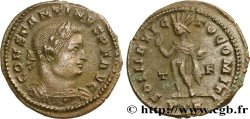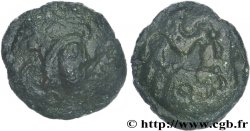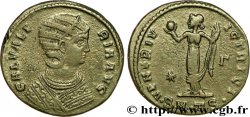MONNAIES 43 (2010)
Precio de inicio : 350.00 €
Valoración : 700.00 €
lote sin vender
Precio de inicio : 350.00 €
Valoración : 700.00 €
lote sin vender
Tipo : Centenionalis ou nummus
Fecha: 321
Nombre del taller / ciudad: Roma
Metal: cobre
Diámetro: 20 mm
Eje de acuñación: 12 h.
Peso: 3,06 g.
Grado de rareza: UNIQUE
Officine: 4e
Emission: 12-13e
Comentarios sobre el estado de conservación:
Exemplaire de qualité exceptionnelle sur un flan large, bien centré des deux côtés avec les grènetis visibles. Portrait de toute beauté. Magnifique revers de haut relief. Très belle patine gris métallique avec des reflets dorés. Conserve l’intégralité de son brillant de frappe et de son coupant d’origine
N° en los catálogos de referencia :
Anverso
Titulatura del anverso: CONSTAN-TINVS AVG.
Descripción del anverso: Tête laurée de Constantin Ier à droite (O*).
Traducción del anverso: “Constantinus Augustus”, (Constantin auguste).
Reverso
Titulatura del reverso: D N CONSTANTINI MAX AVG/ VOT/./ XX/ -|-// R( )Q.
Descripción del reverso: Légende dans une couronne.
Traducción del reverso: “Domini Nostri Constantini Maximo Augusti/ Votis vicennalibus”, (À notre seigneur Constantin très grand auguste, vœux pour le vingtième anniversaire de règne).
Comentario
Avec l’intégralité de son argenture superficielle. Rubans de type 2 aux extrémités bouletées. Semble complètement inédit et non répertorié avec la marque d’atelier espacée. Nous remarquons entre le R de l’atelier et le Q de l’officine, une distance de 2 millimètres alors que les lettres sont normalement collées ou très proches pour les monnaies de la treizième émission de 321 dans sa première phase (RIC. 232) connue seulement pour la première officine ou dans sa deuxième phase (RIC. 237) recensée pour les quatre officines de l’atelier de Rome en fonctionnement alors. Notre exemplaire apporte une nouvelle hypothèse très intéressante. Notre type serait en fait un nummus de la 12e émission (RIC. 225) répertorié seulement pour la première officine (P) où la marque du milieu (eu) aurait été arasée sur le coin de revers au début de la treizième émission en l’absence de nouveaux coins de revers préparés d’où la distance entre le R et le Q.
With all of its surface silvering. Type 2 ribbons with rounded ends. Appears completely unpublished and unlisted with the spaced mint mark. We note between the R of the mint and the Q of the officina, a distance of 2 millimeters while the letters are normally stuck or very close for the coins of the thirteenth issue of 321 in its first phase (RIC. 232) known only for the first officina or in its second phase (RIC. 237) listed for the four officinas of the Rome mint in operation at the time. Our example brings a new and very interesting hypothesis. Our type would in fact be a nummus of the 12th issue (RIC. 225) listed only for the first officina (P) where the middle mark (eu) would have been leveled on the reverse die at the beginning of the thirteenth issue in the absence of new reverse dies prepared, hence the distance between the R and the Q
With all of its surface silvering. Type 2 ribbons with rounded ends. Appears completely unpublished and unlisted with the spaced mint mark. We note between the R of the mint and the Q of the officina, a distance of 2 millimeters while the letters are normally stuck or very close for the coins of the thirteenth issue of 321 in its first phase (RIC. 232) known only for the first officina or in its second phase (RIC. 237) listed for the four officinas of the Rome mint in operation at the time. Our example brings a new and very interesting hypothesis. Our type would in fact be a nummus of the 12th issue (RIC. 225) listed only for the first officina (P) where the middle mark (eu) would have been leveled on the reverse die at the beginning of the thirteenth issue in the absence of new reverse dies prepared, hence the distance between the R and the Q








 Informar de un error
Informar de un error Imprimir la página
Imprimir la página Comparte mi selección
Comparte mi selección Haz una pregunta
Haz una pregunta Consignar / vender
Consignar / vender
 Descriptivo
Descriptivo















